Assessment of the Irrigation Water Requirement and Water Supply Risk in the Tarim River Basin, Northwest China
Abstract
1. Introduction
2. Materials and Methods
2.1. Study Area
2.2. Datasets
2.2.1. Meteorological Data
2.2.2. Runoff and Groundwater Data
2.2.3. Socio-Economic Statistical Data
2.2.4. Land Use Data
2.2.5. GRACE Data
2.3. Methods
2.3.1. Calculation of Reference Evapotranspiration, Crop Water Requirement, and Irrigation Water Requirement
2.3.2. Extracting Crop Planting Structure Based on Statistical and Remote Sensing Data
2.3.3. Terrestrial Water Storage Calculations
3. Results
3.1. Crop Water Requirement and its Trend
3.2. Variations of the Crop Growing Area and Spatial-Temporal Distribution of the Irrigation Water Requirement
3.3. Effects of the Increasing Irrigation Water Requirement on TWS and Groundwater Level
3.4. Analysis of Water Requirement and Supply Risk in Irrigation Areas of Four Headwaters of the Tarim River Basin
4. Discussion
5. Conclusions
- (1)
- In 2015, the total IWR was 471.89 × 108 m3, an increase of 278.74 × 108 m3 compared to 1990. For roughly the first half (1990–2002) of the study period, the total IWR remained relatively consistent at 200 × 108 m3. From 2003, however, the IWR steadily rose, increasing to 471.89 × 108 m3 by 2015. The main reason for the 2003–2015 increase is that the southern Xinjiang region had started an extensive cotton-planting project and also promoted the fruit industry.
- (2)
- Among the five main crops (rice, wheat, maize, cotton, and fruit trees) grown in the TRB, cotton had the largest water requirement. The IWR of cotton reached 227.53 × 108 m3 in 2015, accounting for 48.2% of the total annual water consumption that year. In terms of the quota of agricultural irrigation water, fruit trees consumed the most (859.6 × 103 m3/km2), followed by cotton, rice, maize, and wheat at 770.2 × 103 m3/km2, 597.6 × 103 m3/km2, 560.1 × 103 m3/km2, and 434.7 × 103 m3/km2, respectively.
- (3)
- With increasing IWR, TWS declined at a rate of −0.27 mm/month over the past 14 years in the TRB and groundwater table dropped obviously. Severe water shortages were detected with IWR/Q ratios of the WKRB, ARB, KGRB, and YRB during 1990–2015 being 0.93, 0.68, 1.05, and 0.79, respectively. Seasonally, as the seasonal variations of river runoff and IWR were not consistent, the water stress was severe especially for May and June. This annual seasonal shortage served to further increase water stress in this region.
Author Contributions
Funding
Acknowledgments
Conflicts of Interest
References
- Shen, Y.; Li, S.; Chen, Y.; Qi, Y.; Zhang, S. Estimation of regional irrigation water requirement and water supply risk in the arid region of Northwestern China 1989–2010. Agric. Water Manag. 2013, 128, 55–64. [Google Scholar] [CrossRef]
- Li, Z.; Chen, Y.; Fang, G.; Li, Y. Multivariate assessment and attribution of droughts in Central Asia. Sci. Rep. 2017, 7, 1316. [Google Scholar] [CrossRef]
- Chen, Y. Ecological Protection and Sustainable Management of the Trim River Basin; Science Press: Beijing, China, 2015. [Google Scholar]
- Fu, M.; Guo, B.; Wang, W.; Wang, J.; Zhao, L.; Wang, J. Comprehensive Assessment of Water Footprints and Water Scarcity Pressure for Main Crops in Shandong Province, China. Sustainability 2019, 11, 1856. [Google Scholar] [CrossRef]
- Shi, X.; Yu, D.; Warner, E.; Sun, W.; Petersen, G.; Gong, Z.; Lin, H. Cross-Reference System for Translating Between Soil Classification of China and Soil Taxonomy. Soil Sci. Soc. Am. J. 2006, 70, 78–83. [Google Scholar] [CrossRef]
- Shi, X.; Yu, D.; Warner, E.; Pan, G.; Petersen, G.; Gong, Z.; Weindorf, C. Soil Database of 1:1,000,000 Digital Soil Survey and Reference System of the Chinese Genetic Soil Classification System. Soil Surv. Horiz. 2004, 45, 129–136. [Google Scholar] [CrossRef]
- Qi, F.; Wei, L.; Si, J.; Su, Y.; Zhang, Y.; Cang, Z.; Xi, H. Environmental effects of water resource development and use in the Tarim River basin of northwestern China. Environ. Geol. 2005, 48, 202–210. [Google Scholar] [CrossRef]
- Sun, T.; Huang, Q.; Wang, J. Estimation of Irrigation Water Demand and Economic Returns of Water in Zhangye Basin. Water 2018, 10, 19. [Google Scholar] [CrossRef]
- Wang, F.; WU, Z.; Wang, Y.; Jiao, W.; Chen, Y. Dynamic monitoring of desertification in the Tarim Basin based on RS and GIS techniques. Chin. J. Ecol. 2017, 36, 1029–1037. [Google Scholar]
- Liu, X.; Shen, Y.; Guo, Y.; Li, S.; Guo, B. Modeling demand/supply of water resources in the arid region of northwestern China during the late 1980s to 2010. J. Geogr. Sci. 2015, 25, 573–591. [Google Scholar] [CrossRef]
- Fang, G.; Chen, Y.; Li, Z. Variation in agricultural water demand and its attributions in the arid Tarim River Basin. J. Agric. Sci. 2018, 156, 1–11. [Google Scholar] [CrossRef]
- Malin, F.; Carl, W. Population and water resources: A delicate balance. Popul. Bull. 1993, 47, 1–36. [Google Scholar]
- Zotarelli, L.; Dukes, M.D.; Romero, C.C.; Migliaccio, K.W.; Morgan, T.K. Step by Step Calculation of the Penman-Monteith Evapotranspiration (FAO-56 Method). Agric. Biol. Eng. 2010. Available online: http://edis.ifas.ufl.edu/ae459 (accessed on 10 May 2016).
- Thevs, N.; Peng, H.; Rozi, A.; Zerbe, S.; Abdusalih, N. Water allocation and water consumption of irrigated agriculture and natural vegetation in the Aksu-Tarim river basin, Xinjiang, China. J. Arid Environ. 2015, 112, 87–97. [Google Scholar] [CrossRef]
- Uniyal, B.; Dietrich, J.; Vu, N.Q.; Jha, M.K.; Arumí, J.L. Simulation of regional irrigation requirement with SWAT in different agro-climatic zones driven by observed climate and two reanalysis datasets. Sci. Total Environ. 2018, 649, 846. [Google Scholar] [CrossRef] [PubMed]
- Smith, M. The application of climatic data for planning and management of sustainable rainfed and irrigated crop production. Agric. Forest Meteorol. 2000, 103, 99–108. [Google Scholar] [CrossRef]
- Liu, X.; Li, Y.; Hao, W. Trend and causes of water requirement of main crops in North China in recent 50 years. Trans CSAE 2005, 21, 155–159. [Google Scholar]
- Xiao, J.; Liu, Z.; Duan, A.; Liu, Z.; Li, X. Studies on Effects of Irrigation Systems on the Grain Yield Constituents and Water Use Efficiency of Winter Wheat. J. Irrig. Drain. 2006, 25, 20–23. [Google Scholar]
- Er-Raki, S.; Chehbouni, A.; Guemouria, N.; Duchemin, B.; Ezzahar, J.; Hadria, R. Combining FAO-56 model and ground-based remote sensing to estimate water consumptions of wheat crops in a semi-arid region. Agric. Water Manag. 2007, 87, 41–54. [Google Scholar] [CrossRef]
- Ye, Q.; Yang, X.; Dai, S.; Chen, G.; Li, Y.; Zhang, C. Effects of climate change on suitable rice cropping areas, cropping systems and crop water requirements in southern China. Agric. Water Manag. 2015, 159, 35–44. [Google Scholar] [CrossRef]
- Li, D.; Luo, H.; Luo, Y.; Gui, Y.; Li, Y.; Meng, Q. Analysis of irrigation water demand and supply in the Lhasa River valley, Tibet. J. Grainage Irrig. Mach. Eng. 2018, 36, 1053–1058. [Google Scholar]
- Guo, B.; Li, W.; Guo, J.; Chen, C. Risk Assessment of Regional Irrigation Water Demand and Supply in an Arid Inland River Basin of Northwestern China. Sustainability 2015, 7, 12958–12973. [Google Scholar] [CrossRef]
- Allen, R.G. Crop Evapotranspiration—Guidelines for Computing Crop Water Requirements; FAO Irrigation and Drainage Paper No.56; FAO: Rome, Italy, 1998; 300p. [Google Scholar]
- Chen, Y.; Ye, Z.; Shen, Y. Desiccation of the Tarim River, Xinjiang, China, and mitigation strategy. Quat. Int. 2011, 244, 264–271. [Google Scholar] [CrossRef]
- Shen, Y.; Chen, Y.; Liu, C.; Chen, Y.; Xu, Z. Global perspective on hydrology, water balance, and water resources management in arid basins. Hydrol. Process. 2010, 24, 129–135. [Google Scholar] [CrossRef]
- Di, L.; Yang, Y.; Wada, Y.; Yang, H.; Wei, L.; Chen, Y.; Yong, B.; Hou, A.; Wei, J.; Lu, C. Deriving scaling factors using a global hydrological model to restore GRACE total water storage changes for China’s Yangtze River Basin. Remote Sens. Environ. 2015, 168, 177–193. [Google Scholar]
- Xu, S.; Yu, Z.; Yang, C.; Ji, X.; Zhang, K. Trends in evapotranspiration and their responses to climate change and vegetation greening over the upper reaches of the Yellow River Basin. Agric. For. Meteorol. 2018, 263, 118–129. [Google Scholar] [CrossRef]
- Gu, S.; He, D.; Cui, Y.; Li, Y. Temporal and spatial changes of agricultural water requirements in the Lancang River Basin. J. Geogr. Sci. 2012, 22, 441–450. [Google Scholar] [CrossRef]
- Han, S.; Xu, D.; Yang, Z. Irrigation-Induced Changes in Evapotranspiration Demand of Awati Irrigation District, Northwest China: Weakening the Effects of Water Saving? Sustainability 2017, 9, 1531. [Google Scholar]
- Shahid, S. Impact of climate change on irrigation water demand of dry season Boro rice in northwest Bangladesh. Clim. Change 2011, 105, 433–453. [Google Scholar] [CrossRef]
- Yang, Y.; Disse, M.; Yu, R.; Yu, G.; Sun, L.; Huttner, P.; Rumbaur, C. Large-Scale Hydrological Modeling and Decision-Making for Agricultural Water Consumption and Allocation in the Main Stem Tarim River, China. Water 2015, 7, 2821–2839. [Google Scholar]
- Jia, H.; Zhang, T.; Yin, X.; Shang, M.; Chen, F.; Lei, Y.; Chu, Q. Impact of Climate Change on the Water Requirements of Oat in Northeast and North China. Water 2019, 11, 91. [Google Scholar] [CrossRef]
- Zhang, L.; Zhang, N.; Ma, Y. Study on Water Use of Walnut Trees under Drip Irrigation. Mod. Agric. Sci. Technol. 2010, 21, 117–121. [Google Scholar]
- Xu, X.; Zhou, H.; Wang, Z.; Rouzi, J. Study on Effective Rainfall Use Efficiency in Arid Irrigation District. Water Sav. Irrig. 2010, 12, 46–50. [Google Scholar]
- Grafton, R.Q.; Williams, J.; Perry, C.J.; Molle, F.; Ringler, C.; Steduto, P.; Udall, B.; Wheeler, S.A.; Wang, Y.; Garrick, D.; et al. The paradox of irrigation efficiency. Science 2018, 361, 748–750. [Google Scholar] [CrossRef] [PubMed]
- Lv, N.; Bai, J.; Chang, C.; Li, J.; Luo, G.; Wu, S.; Ding, J. Spatial-temporal changes in evapotranspiration based on planting patterns of major crops in the Xinjiang oasis during 1960–2010. Geogr. Res. 2017, 36, 1443–1454. [Google Scholar]
- Cheng, M.; Ries, J.C.; Tapley, B.D. Variations of the Earth’s figure axis from satellite laser ranging and GRACE. J. Geophys. Res. Solid Earth 2015, 116, B01409. [Google Scholar] [CrossRef]
- Swenson, S.; Chambers, D.; Wahr, J. Estimating geocenter variations from a combination of GRACE and ocean model output. J. Geophys. Res. Solid Earth 2008, 113. [Google Scholar] [CrossRef]
- Geruo, A.; Wahr, J.; Zhong, S.J. Computations of the viscoelastic response of a 3-D compressible Earth to surface loading: An application to Glacial Isostatic Adjustment in Antarctica and Canada. Geophys. J. Int. 2013, 192, 557–572. [Google Scholar]
- Deng, H.; Pepin, N.C.; Liu, Q.; Chen, Y. Understanding the spatial differences in terrestrial water storage variations in the Tibetan Plateau from 2002 to 2016. Clim. Change 2018, 151, 379–393. [Google Scholar] [CrossRef]
- Wahr, J.; Swenson, S.; Velicogna, I. Accuracy of GRACE mass estimates. Geophys. Res. Lett. 2006, 33, 178–196. [Google Scholar] [CrossRef]
- Deng, H.; Chen, Y. Influences of recent climate change and human activities on water storage variations in Central Asia. J. Hydrol. 2016, 544, 46–57. [Google Scholar] [CrossRef]
- Falkenmark, M.R., Jr. Balancing Water for Humans and Nature: An Ecohydrological Approach for Sustainability; Earthscan Publications: London, UK, 2004; p. 247. [Google Scholar]
- Wang, Y.; Dahe, Q. Influence of climate change and human activity on water resources in arid region of Northwest China: An Overview. Clim. Change Res. 2017, 13, 483–493. [Google Scholar] [CrossRef]
- Chen, Y.; Li, Z.; Li, W.; Deng, H.; Shen, Y. Water and ecological security: Dealing with hydroclimatic challenges at the heart of China’s Silk Road. Environ. Earth Sci. 2016, 75, 881. [Google Scholar] [CrossRef]
- Kang, J.; Zi, X.; Wang, S.; He, L. Evaluation and Optimization of Agricultural Water Resources Carrying Capacity in Haihe River Basin, China. Water 2019, 11, 999. [Google Scholar] [CrossRef]
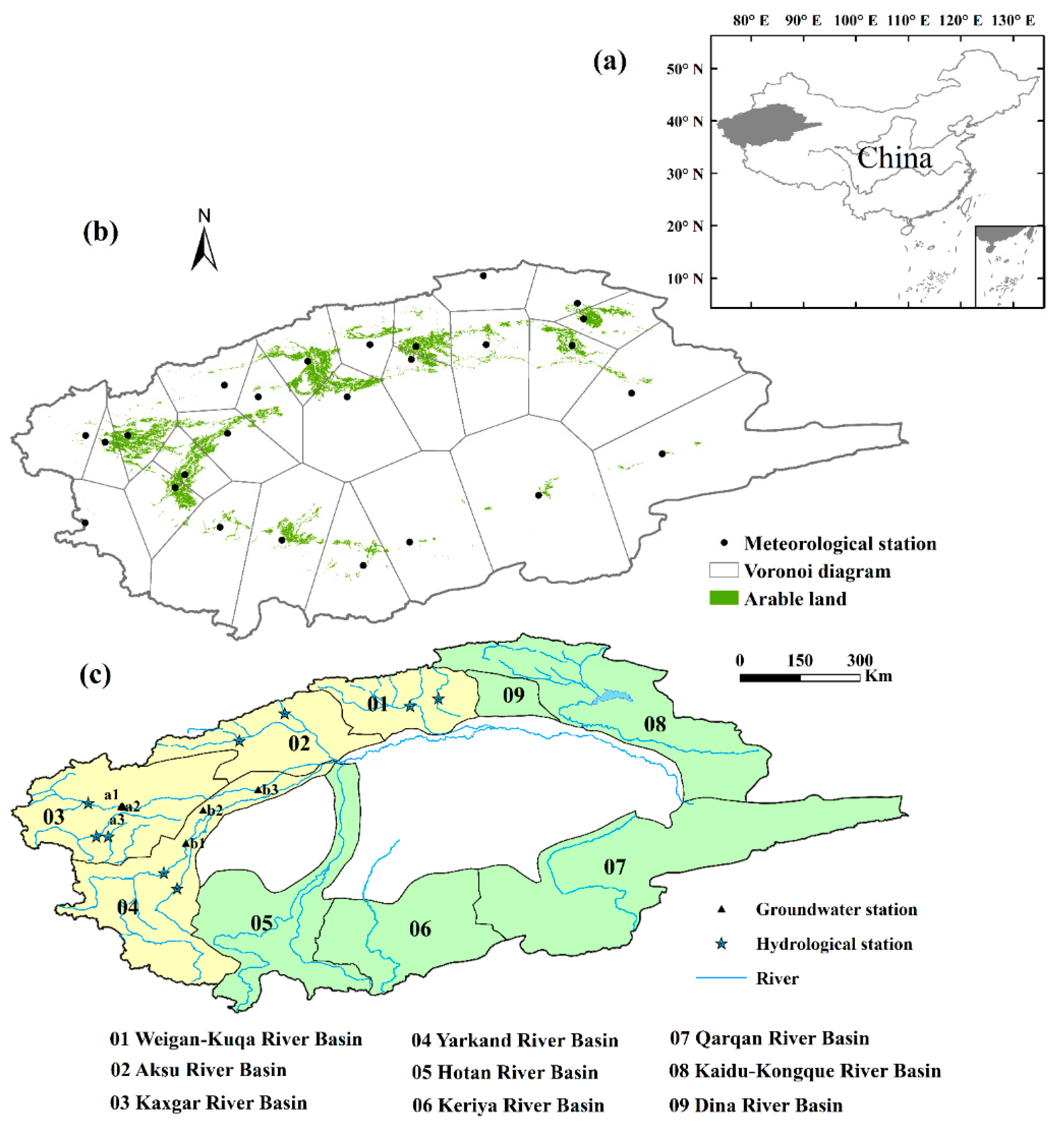
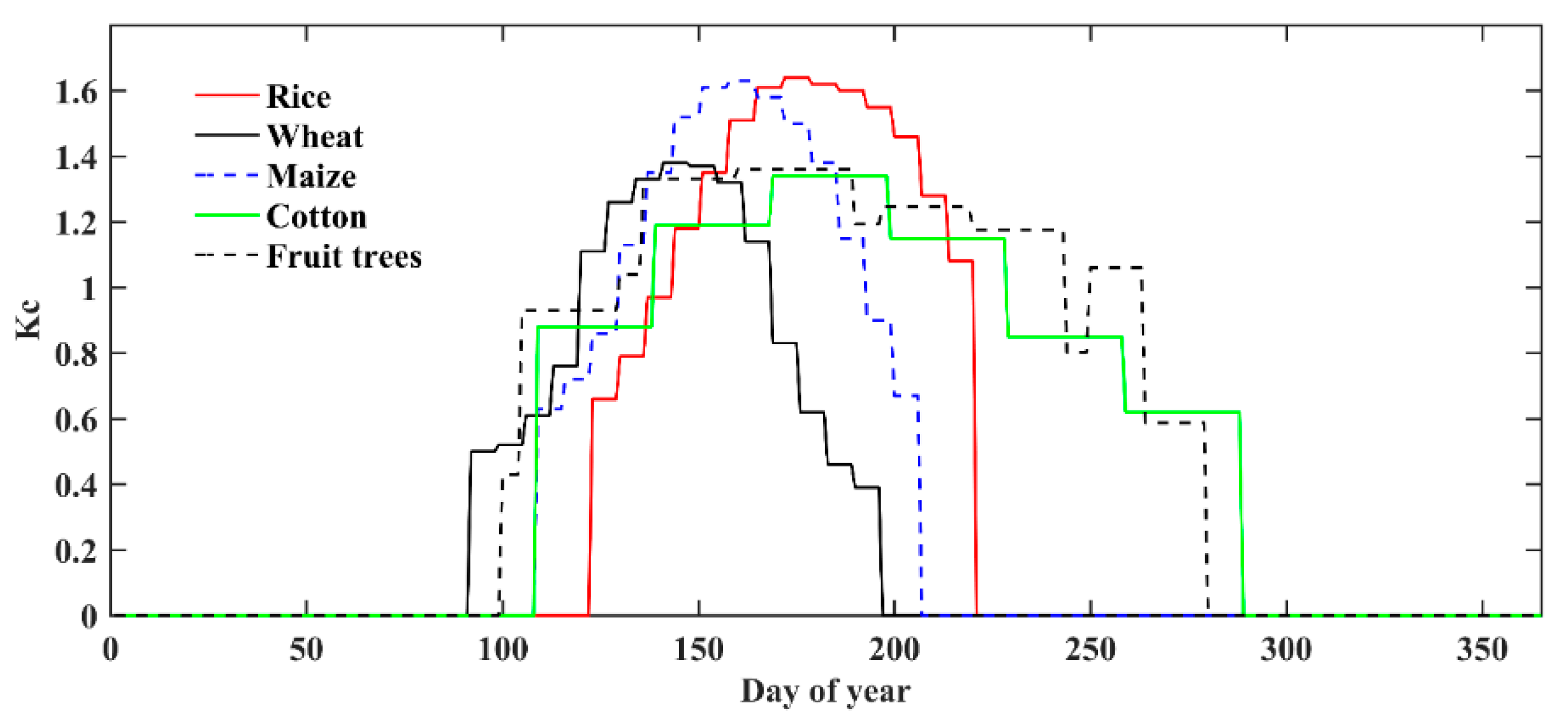
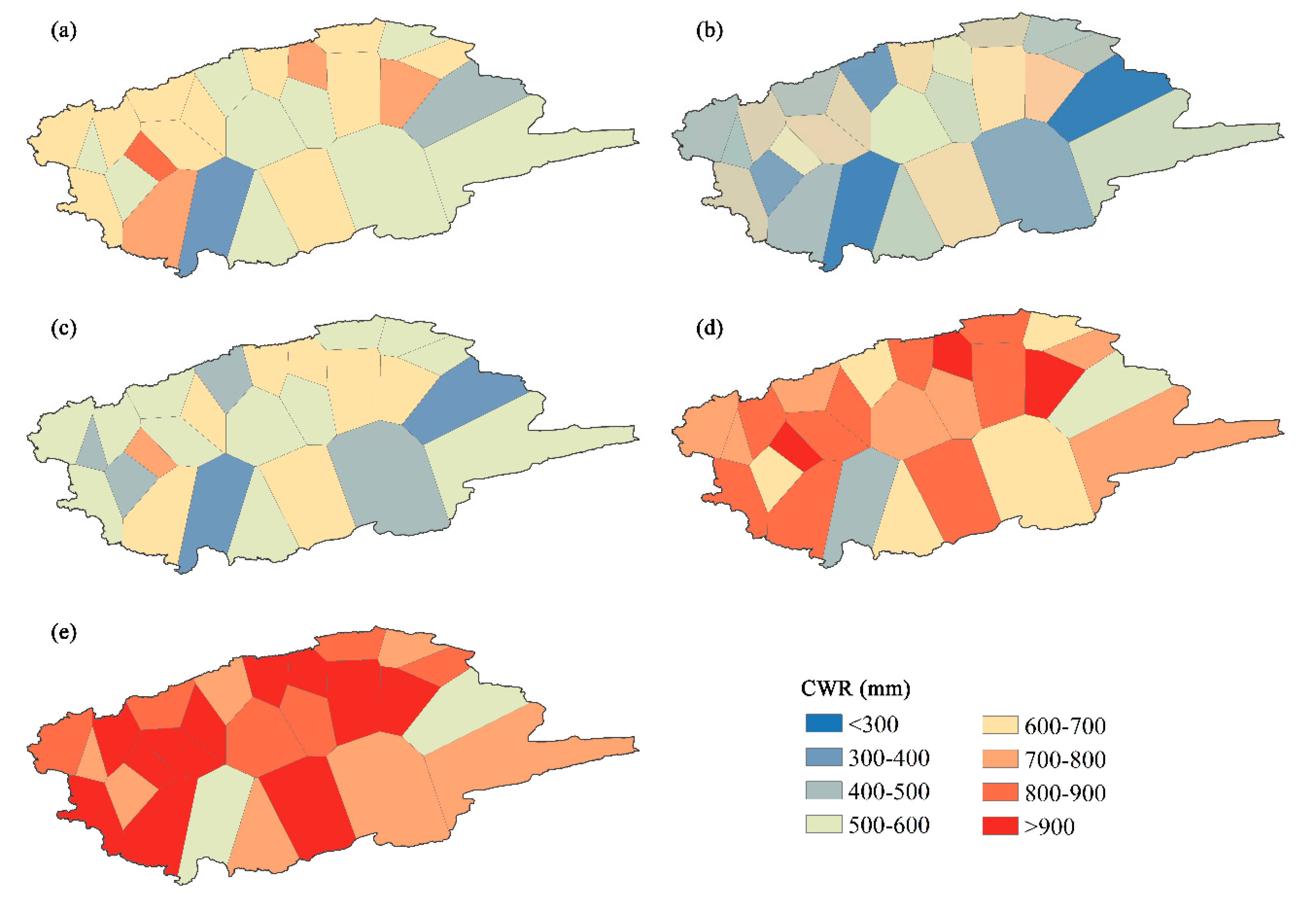

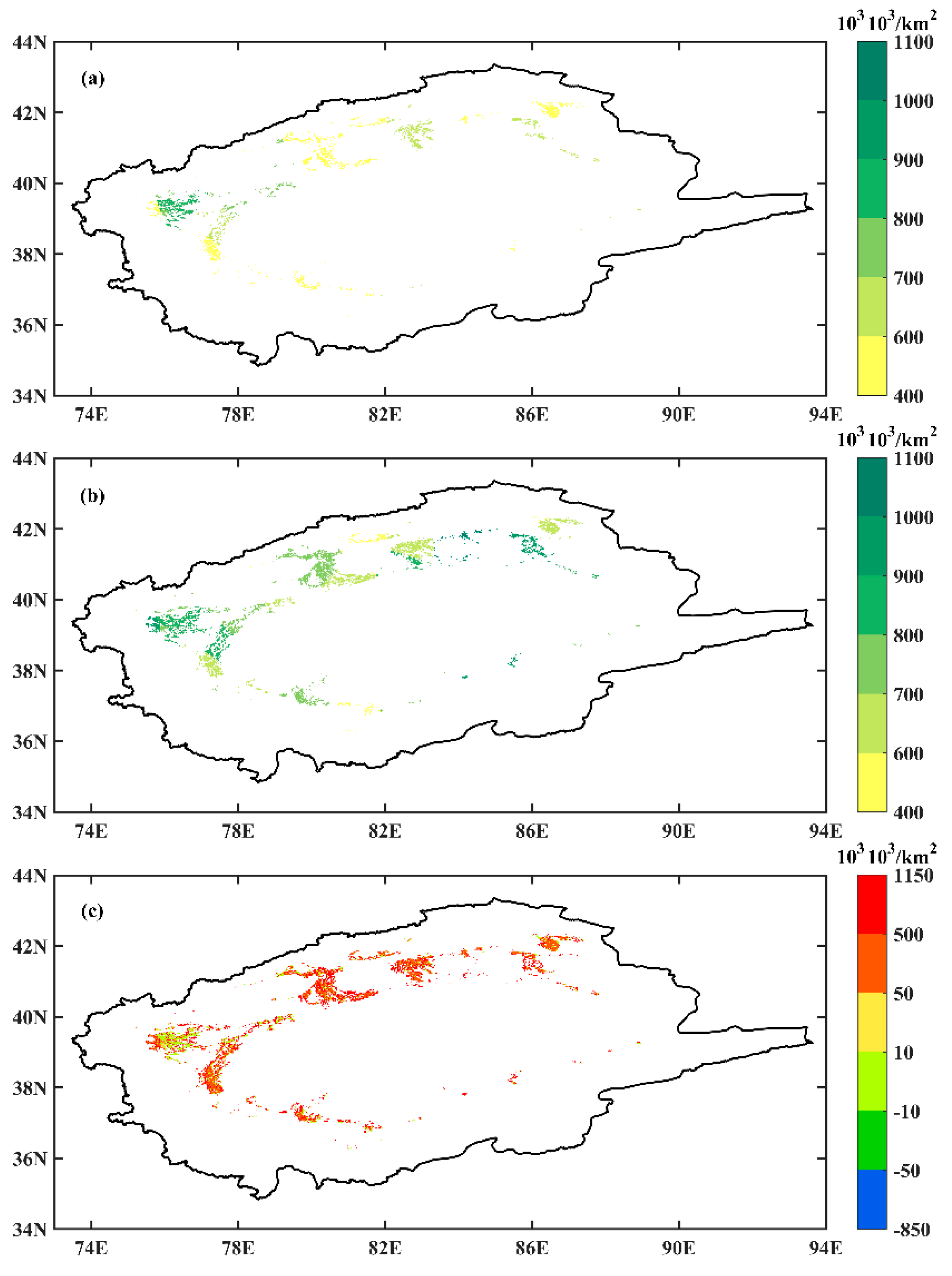

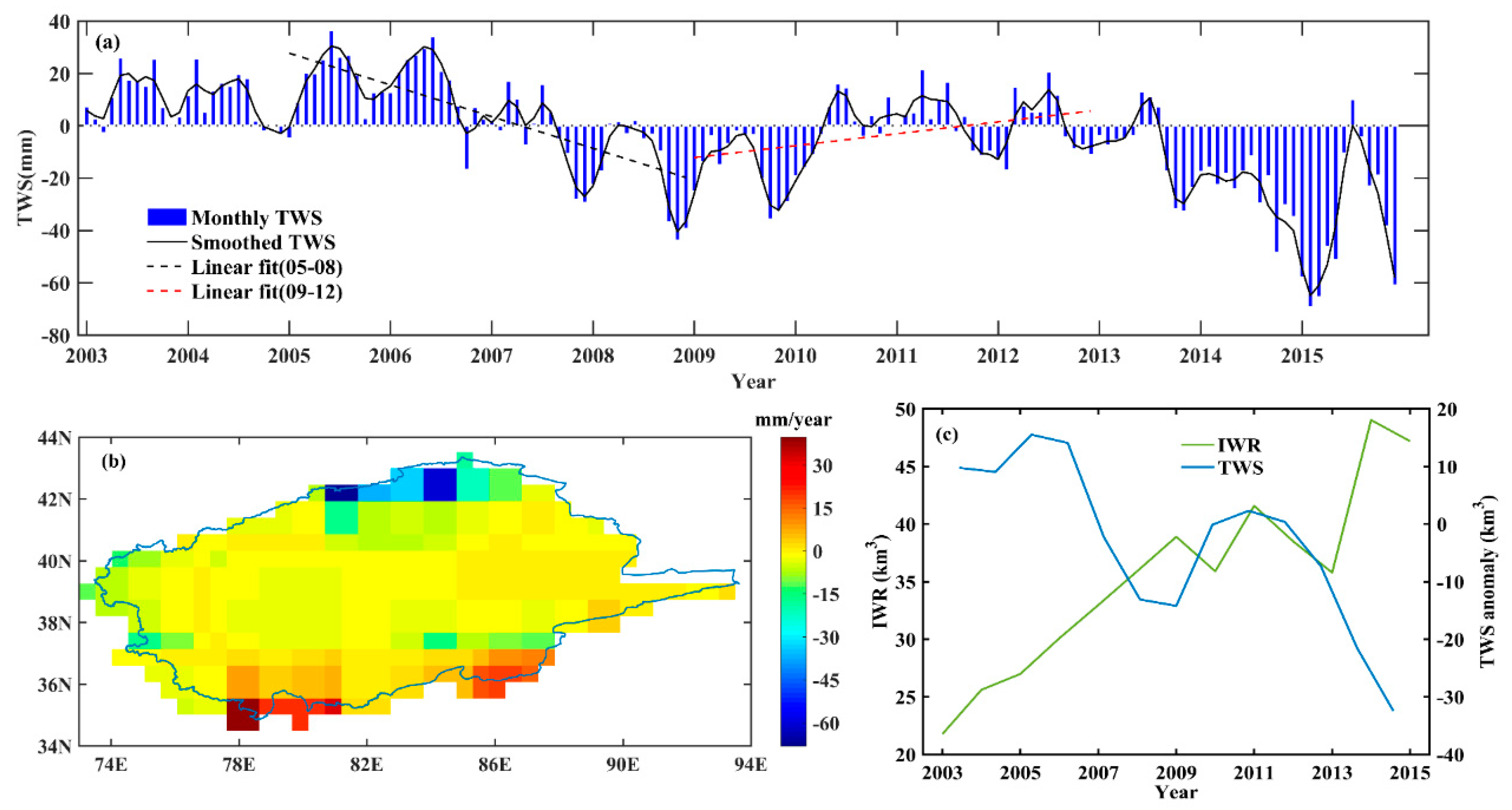
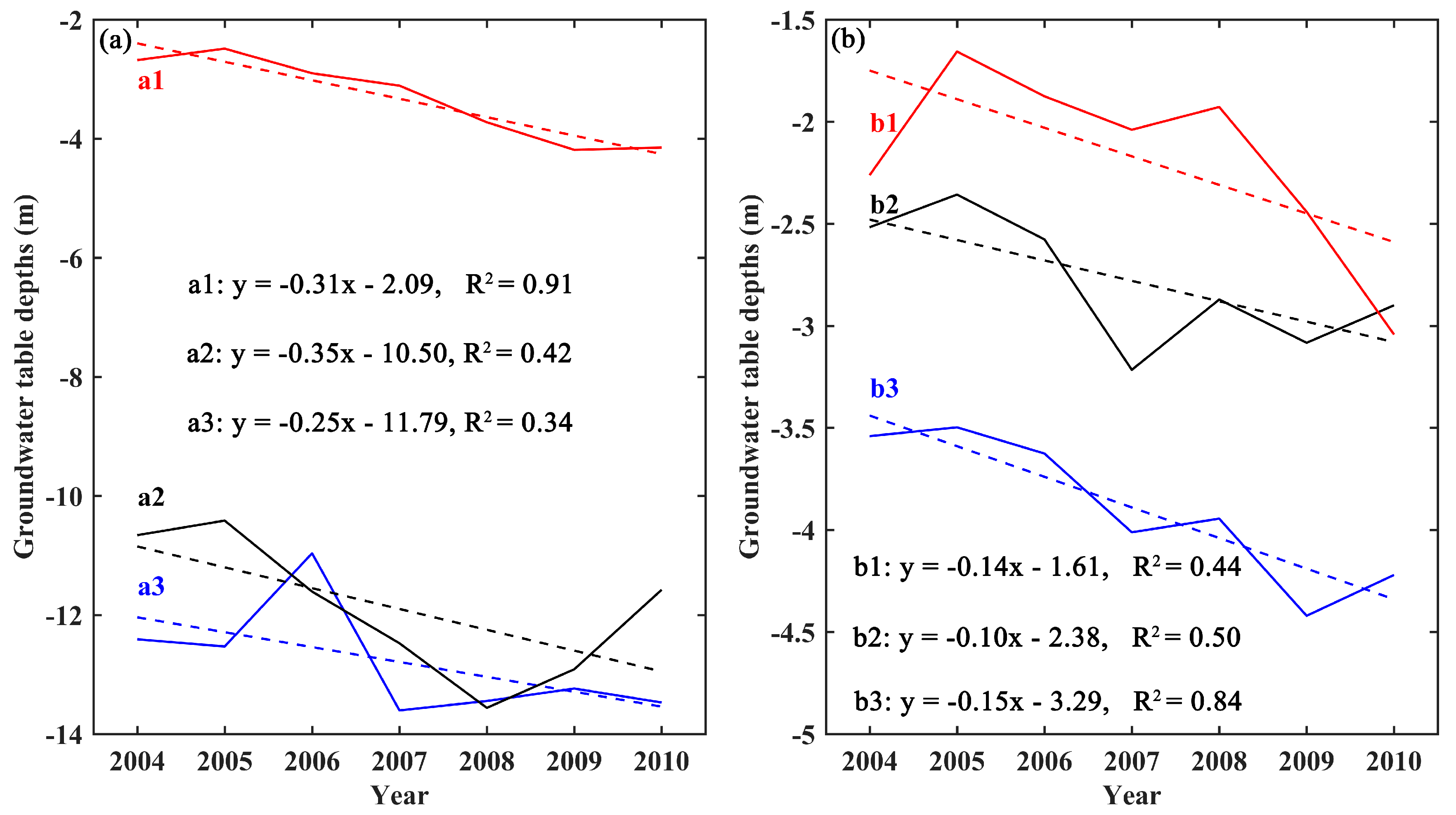
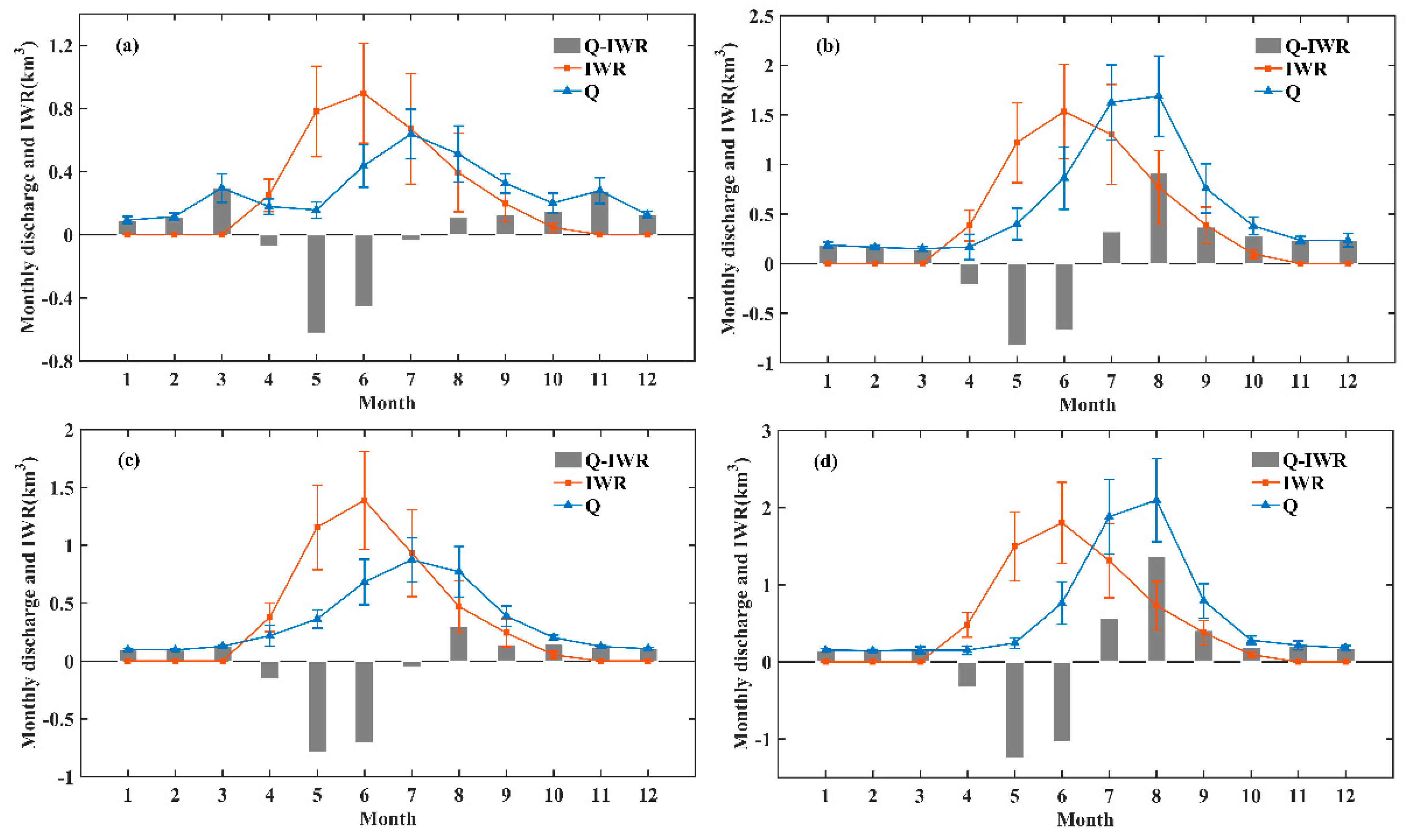
| Year | 1990 | 1995 | 2000 | 2005 | 2010 | 2015 |
|---|---|---|---|---|---|---|
| Irrigation water efficiency | 0.38 | 0.40 | 0.42 | 0.45 | 0.48 | 0.52 |
| Region | Rice | Wheat | Maize | Cotton | Fruit trees | ET0 | P | Tmax (°C) | Tmin (°C) |
|---|---|---|---|---|---|---|---|---|---|
| WKRB | 553 | 387 | 496 | 699 | 777 | 902.76 | 121.95 | 15.77 | 2.33 |
| MK trend | 2.946 ** | 2.267 ** | 2.713 ** | 4.335 ** | 4.809 ** | 5.62 ** | −0.15 | 0.02 | 0.03 ** |
| ARB | 593 | 416 | 535 | 747 | 828 | 972.38 | 118.45 | 18.00 | 4.55 |
| MK trend | 0.867 | 1.147 * | 1.087 | 1.320 | 1.545 | 3.09 ** | 0.63 | 0.02 | 0.03 ** |
| KGRB | 639 | 440 | 571 | 804 | 890 | 1057.29 | 117.51 | 17.11 | 4.27 |
| MK trend | 2.160 * | 1.972 ** | 2.190 ** | 2.706 * | 3.043 * | 4.70 ** | 0.77 | 0.02 | 0.04 ** |
| YRB | 605 | 426 | 545 | 763 | 846 | 998.39 | 72.58 | 18.43 | 4.28 |
| MK trend | 1.946 * | 1.534 * | 1.863 * | 2.679 * | 2.976 * | 4.85 ** | 0.51 | 0.03 | 0.03 * |
| TRB | 609 | 429 | 548 | 774 | 858 | 1015.58 | 96.48 | 17.69 | 4.02 |
| MK trend | 2.513 ** | 1.803 ** | 2.156 ** | 3.649 ** | 4.055 ** | 5.62 ** | 0.33 | 0.03 | 0.04 ** |
| Year | 1990 | 1995 | 2000 | 2005 | 2010 | 2015 |
|---|---|---|---|---|---|---|
| Rice | 6.41 | 5.47 | 6.35 | 6.79 | 3.84 | 3.59 |
| Wheat | 47.20 | 40.03 | 42.66 | 40.60 | 48.88 | 60.03 |
| Maize | 31.22 | 28.54 | 26.24 | 32.43 | 40.99 | 50.32 |
| Cotton | 28.17 | 48.56 | 59.79 | 64.19 | 87.69 | 146.72 |
| Fruit trees | 9.92 | 10.39 | 12.05 | 37.68 | 77.82 | 74.65 |
| All | 122.91 | 133.00 | 147.07 | 181.68 | 259.22 | 335.30 |
| Year | WKRB | ARB | KGRB | YRB | ||||||||
|---|---|---|---|---|---|---|---|---|---|---|---|---|
| IWR | Q | IWR/Q | IWR | Q | IWR/Q | IWR | Q | IWR/Q | IWR | Q | IWR/Q | |
| 1990–2002 | 21.6 | 33.7 | 0.64 | 40.0 | 86.9 | 0.46 | 34.7 | 38.5 | 0.90 | 46.9 | 77.1 | 0.61 |
| 2003–2015 | 43.2 | 36.3 | 1.19 | 73.9 | 79.5 | 0.93 | 57.7 | 49.5 | 1.17 | 79.1 | 83.1 | 0.95 |
| Average | 32.4 | 35.0 | 0.93 | 56.9 | 83.2 | 0.68 | 46.2 | 44.0 | 1.05 | 63.0 | 80.1 | 0.79 |
© 2019 by the authors. Licensee MDPI, Basel, Switzerland. This article is an open access article distributed under the terms and conditions of the Creative Commons Attribution (CC BY) license (http://creativecommons.org/licenses/by/4.0/).
Share and Cite
Wang, F.; Chen, Y.; Li, Z.; Fang, G.; Li, Y.; Xia, Z. Assessment of the Irrigation Water Requirement and Water Supply Risk in the Tarim River Basin, Northwest China. Sustainability 2019, 11, 4941. https://doi.org/10.3390/su11184941
Wang F, Chen Y, Li Z, Fang G, Li Y, Xia Z. Assessment of the Irrigation Water Requirement and Water Supply Risk in the Tarim River Basin, Northwest China. Sustainability. 2019; 11(18):4941. https://doi.org/10.3390/su11184941
Chicago/Turabian StyleWang, Fei, Yaning Chen, Zhi Li, Gonghuan Fang, Yupeng Li, and Zhenhua Xia. 2019. "Assessment of the Irrigation Water Requirement and Water Supply Risk in the Tarim River Basin, Northwest China" Sustainability 11, no. 18: 4941. https://doi.org/10.3390/su11184941
APA StyleWang, F., Chen, Y., Li, Z., Fang, G., Li, Y., & Xia, Z. (2019). Assessment of the Irrigation Water Requirement and Water Supply Risk in the Tarim River Basin, Northwest China. Sustainability, 11(18), 4941. https://doi.org/10.3390/su11184941








